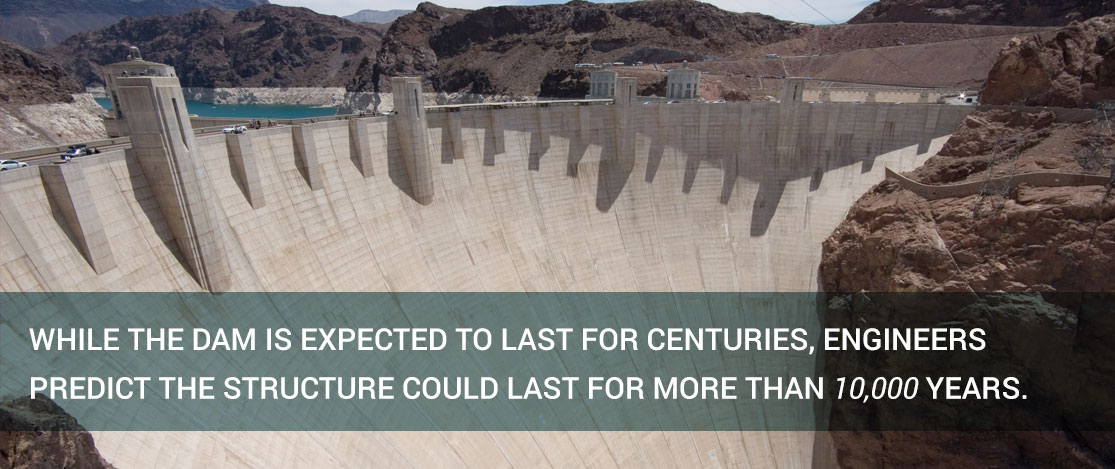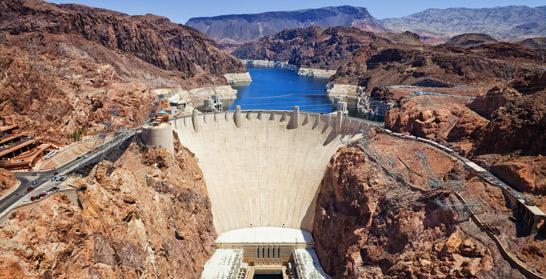Only an anthropologist would imagine a world without humans. Only an anthropological engineer would imagine what monuments of human civilization would survive the longest for other intelligent life to examine. And only an architect would say it’s probably the Hoover Dam, the massive concrete structure built on the Colorado River in the early 1930s.
What makes this man-made structure of 3.3 million cubic yards of Hoover Dam concrete so magnificent and so seemingly everlasting?
Simply put, it’s the way the dam was built, a modern marvel even by today’s standards.
Who’s Big Idea?
The U.S. Bureau of Reclamation developed plans to build the dam along the border of Arizona and Nevada nearly a century ago. Originally named The Boulder Dam, its purpose was to corral the Colorado River, to harness the river’s power to provide electricity for the growing Southwest, and to direct water to developing agricultural regions.
The 7-year timeline for dam construction, however, proved initially challenging, although contractors were later able to complete the project in four years, by 1936.
In 1922 bureau director Arthur Powell presented a plan to Congress for the dam in Black Canyon. Construction of the dam would eventually cost $49 million ($700 million by today’s valuations).
Secretary of Commerce Herbert Hoover’s negotiations over the 1922 Colorado River Compact to direct the water to the seven nearby states was met with legal challenges until President Calvin Coolidge authorized the project in late 1928. Government officials decided to rename the dam in honor of Hoover; however, the name change became official in 1947.
Getting Stronger Every Day?
Two concrete plants were built on the project site for construction. Railcars carried the fresh concrete for the dam in 4 by 8 cubic-yard buckets with overhead cableways lowering the concrete to the dam forms. During peak production, concrete buckets were delivered every 78 seconds.
The Hoover Dam’s base required 230 blocks of concrete, each block five feet in height. Widths of the blocks varied from 25 square feet to 60 square feet depending on the blocks’ location. Columns of blocks were linked in alternating and interconnecting arrangements.
The Hoover Dam concrete would cure in 125 years by conventional or natural methods. Crews, however, used some innovative engineering methods to hasten the process.
Nearly 600 miles of steel pipes woven through the concrete blocks significantly reduced the chemical heat from the setting for the concrete. Crews relied on 1,000-pound blocks of ice produced daily at the site’s ammonia-refrigeration plant.
The pipes that were used to cool the large blocks were later filled with concrete for additional strength. With its 80-year-old technologies and construction methods, the Hoover Dam maintains water-pressure levels of up to 45,000 pounds per square inch. The project uses engineering and physics concepts known as arch-gravity and gravity dam, meaning some of the force of the Colorado River water is redirected upstream or against canyon walls. Simply put, the arch-gravity Hoover Dam curves upstream to direct water pressure outward and against the canyon walls.
The Dam Future

While the dam is expected to last for centuries, engineers predict the structure could last for more than 10,000 years, surpassing most remnants of human civilization if humans were to disappear from the earth. However, they also predict the dam’s turbines without human intervention would shut down within two years.
We at Del Zotto Products hoped you enjoyed our journey through history. We have been in the concrete business for more than 50 years, providing the industry the highest level of service and the most advanced equipment systems. Stop by our office and contact us today. We’d love to hear from you.

